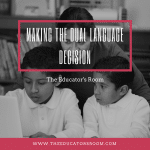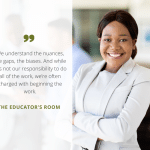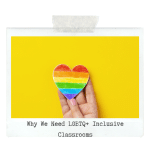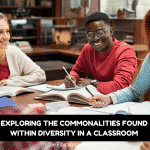People are like plants. They need the proper climate to grow, and no two plants share the exact same ideal for quality conditions. Students are the same in this individual need for a particular climate. Like an Aspen tree planted in the desert of Arizona, we should not expect students to flourish in environments that are entirely unfamiliar to their own.
Our schools continue to become more diverse, yet our curriculum is still one-size-fits-all as if every student will fit into the same box. The shape curriculum has taken, the climate it has produced is one of Anglo-normative fashion, suited primarily for white students. The statistics of actual diversity and the inclusion found within educational material do not share the same trajectory.
“Sixty-five years after Brown v. Board of Education, schools remain largely segregated by race. Predominantly White school districts receive far more funding compared with districts that serve mostly students of color. Black and Brown children are more likely to be suspended than their peers for the same infractions, and research shows that non-Black teachers often have lower educational expectations for Black students than White students.“
–Villavicencio, Hill, and Klevan
Every literature textbook I ever opened was written by predominantly white people, if not every contributor. History has shown our failure to incorporate widespread diversity in the classroom. Take a look at a history class and its capacity for selective memory.
Part of the issue, in terms of racial inclusion, is the use of tokenism. By reaching the bare minimum for diversity in the curriculum, the range of perspectives any group of people has to offer is ignored, leaving their identity to be dictated by a lone representation. This is not fair to the individuals who make up any given culture and can even lead to cases of imposter syndrome.
“The single story creates stereotypes, and the problem with stereotypes is not that they are untrue, but that they are incomplete. They make one story become the only story.“
No Culture Left Behind
Narrow-minded attitudes found in instruction–the mindset of focusing entirely on one’s own culture, however unconscious–only perpetuate the same conditioned resistance to true integration in public schools. According to the research of Choi and Lee, “teachers often teach according to their own cultural biases, with teacher preparation programs being far from successful when it comes to incorporating multicultural perspectives into their programs.” This lack of inclusion does little to engage with students that do not relate to their teachers.
While racial diversity is a highly important factor in creating an inclusive education system, we cannot overlook every other group of disadvantaged people. With an increase in racial identities across the United States, there organically comes a rise in different types of people. Bias on the basis of gender, sexual orientation, religious affiliation, physical ability, socioeconomic status, race, and anything that is perceived as straying from the societal notion of normal, exist as commonplace in classrooms across the country. Nobody is safe from these biases, either.
“When teachers are fired because of their sexual orientation, gender identity, or gender expression, it sends a clear message to students and teachers about how LGBTQ people are perceived and treated.“
The staff members are a part of the realm of social influence within the walls of a school. The number of administrators or teachers that qualify as “diverse hires,” as well as how they are treated by surrounding staff members, can impact the students who identify in similar groups of people. A study completed by Queens University of Charlotte states how “Promoting diversity in staffing also enables students from different backgrounds to identify with teachers, effectively enhancing their trust in a learning environment.” So not only does a diverse curriculum yield positive results, a diverse team of professionals can foster an accepting and successful school.
Taking Initiative in Your Classroom
For teachers that fall within Anglo- and heteronormative categories, your instruction, and use of curriculum are the greatest tools you have to combat homogenized textbooks, workbooks, representations of media, and examples of human ingenuity, triumph, or mastery.
We, as people, must look at our own intake of media. Everything we do, see, taste, smell, and hear shapes the type of person we become and continue to be. This comes out in how we teach and create our own molds of expectations as teachers. It is easy to believe your life is inclusive, but start to pay more attention to the use of tokenism in the media and you will notice the disparity.
The internet shattered borders and much of the gatekeeping that limited diversification. It is working to do the same with barriers. Voices can be shared, heard, and shared again online. Voices that were kept silent for generations. There is no excuse as educators to not consider these modern pioneers of social equality when examining any part of humanity in a modern world. You teach in order to prepare kids for the future and to learn from the past. Not repeat it.
In a world where normativity is constantly being questioned in American culture, diversity is waiting patiently for you. Include yourself.
Changing Subjects
No subject is excluded from this need for inclusion. There is an abundance of literary and historical texts that can be used to encompass a world of perspectives. These two subjects seem to have it the easiest but should still strive to find different experiences to share in the classroom. This is one of the best opportunities for students to gain a global perspective.
As for STEM classes, diverse representation matters as much as the information being taught. When students who struggle with connecting to their work discover contributions in the field of math and science made by great minds that they can relate to, the motivation needed to invest themselves in the material increases. Inspiration can be provided in many forms by a teacher.
In fact, a diversified team of scientists and mathematicians may outperform a homogenized team. An analysis of a PNAS study on this topic states how the results “suggest [that] this is because people with different backgrounds have different experiences and perspectives, and because of this, they approach problems differently, ask different questions, and develop more innovative solutions.” How’s that for stereotypes?
Organic diversity is the outcome of embracing diversity as a natural occurrence, driven by the intent to listen and the desire to understand other people. We should not merely diversify for the sake of diversity. Be inclusive because you share the dream of a better future for everyone.
Although the definition of the word itself refers to differences, diversity should not be conducted as a mandatory acceptance of people’s differences, but seen as “a combination of our differences that shape our view of the world.” We can’t ignore the varying experiences disadvantaged people have in society, but everyone in this world can lay claim to traits beyond their societal obstacles. We need to acknowledge the struggles and successes of each individual. That way, everyone is given room to grow.






